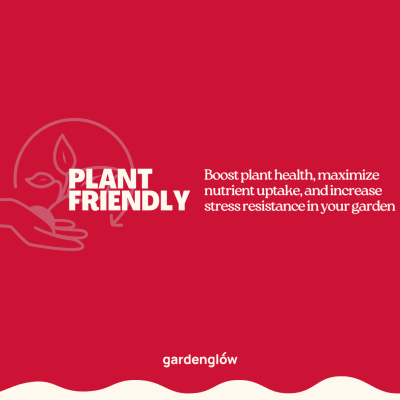Uncategorized
GardenGlow FAQ
GardenGlow is a microbial inoculant containing essential plant growth-promoting bacteria that provide lasting benefits to your garden microbiome by enhancing natural plant processes for nutrient cycling, stress tolerance, disease suppression, and growth.
Why is it important to build a healthy garden microbiome?
The garden microbiome refers to the diverse community of microorganisms (such as bacteria, fungi, and viruses) that live in and around plant tissues, including roots, stems, leaves, seeds, and soil.Just like the human gut microbiome, the microbiome in your garden plays a crucial role in supporting the health and growth of plants.
What are the main benefits of GardenGlow?
GardenGlow promotes Earth-friendly growth, enhances nutrient uptake, and improves resilience to environmental stressors such as heat, drought, and salinity by enriching the plant and soil
microbiome in your garden with a synergistic community of beneficial bacteria that support long-term ecosystem regeneration.



Can I use GardenGlow on other plants than tomatoes?
Yes! In addition to tomatoes and vegetables, GardenGlow may be used on a variety of garden crops such as berries, herbs, flowers, and turf grass.
How much GardenGlow do I need to treat my garden?
A single pack of GardenGlow covers a 100 square foot garden (10 ft x 10 ft). We recommend applying GardenGlow 1 to 3 times per growing season. For gardens impacted by more severe drought, heat, salinity, or other stressors, we recommend reapplying GardenGlow at 2-month intervals.
How do I use GardenGlow?
To prepare, add 1 pack of GardenGlow to a 2 gallon watering can and mix well to homogenize. Apply the GardenGlow watering solution on up to 100 ft2 of garden by pouring over soil and pots.
Can I save excess GardenGlow if my garden is less than 100 ft2?
While we do not recommend saving GardenGlow after it’s been diluted with water, over applying is not a concern so any excess GardenGlow can be safely poured over the soil or plants in your garden treatment area.
How do I store GardenGlow before applying it to my garden?
For best results, store GardenGlow in the freezer for up to 1 year.
How is GardenGlow different from other gardening products such as N-P-K fertilizers?
Compared to N-P-K fertilizers which need to applied frequently, a single GardenGlow treatment colonizes beneficial bacteria inside plants, roots, and soil and enhances natural plant processes that boost nutrient cycling and stress resilience with lasting effects.
What are the environmental benefits of using a microbial inoculant such as GardenGlow to support plant health compared to synthetic fertilizers and pesticides?
Building a healthy garden microbiome can reduce the reliance on synthetic fertilizers and pesticides, translating Regenerative Agriculture practices that minimize the negative impacts of chemical inputs on the environment to the home garden (a concept we call “Regenerative Gardening”).
What is Regenerative Gardening on how does it differ from other agricultural principles such as “organic” and “sustainability”?
Regenerative Gardening is a holistic agricultural approach that focuses on actively restoring ecosystems with a particular emphasis on improving biodiversity and soil health. While organic growing focuses on avoiding synthetic chemical inputs and sustainability aims to maintain resources for the future, Regenerative Gardening seeks to actively improve the health of garden ecosystems and soil over time.
How does Regenerative Gardening relate to Regenerative Agriculture?
Regenerative Agriculture is a set of principles and practices that aim to restore deteriorated land used for commercial food production with the goal of simultaneously mitigating global food insecurity and the negative impacts of agricultural intensification on the environment. GardenGlow hopes to foster a Regenerative Gardening movement among a community of eco-conscience home gardeners.
What are some Regenerative Gardening principles and practices?
Regenerative principles and practices involve less soil disturbance, year-round living roots, biodiversity, fewer synthetic inputs, livestock integration, and composting for soil organic matter. These methods enhance soil health, sequester carbon, conserve biodiversity, and reduce water pollution. However, contextual adaptation of regenerative techniques to different environments, geographic contexts, and growing systems is crucial to their effectiveness.



